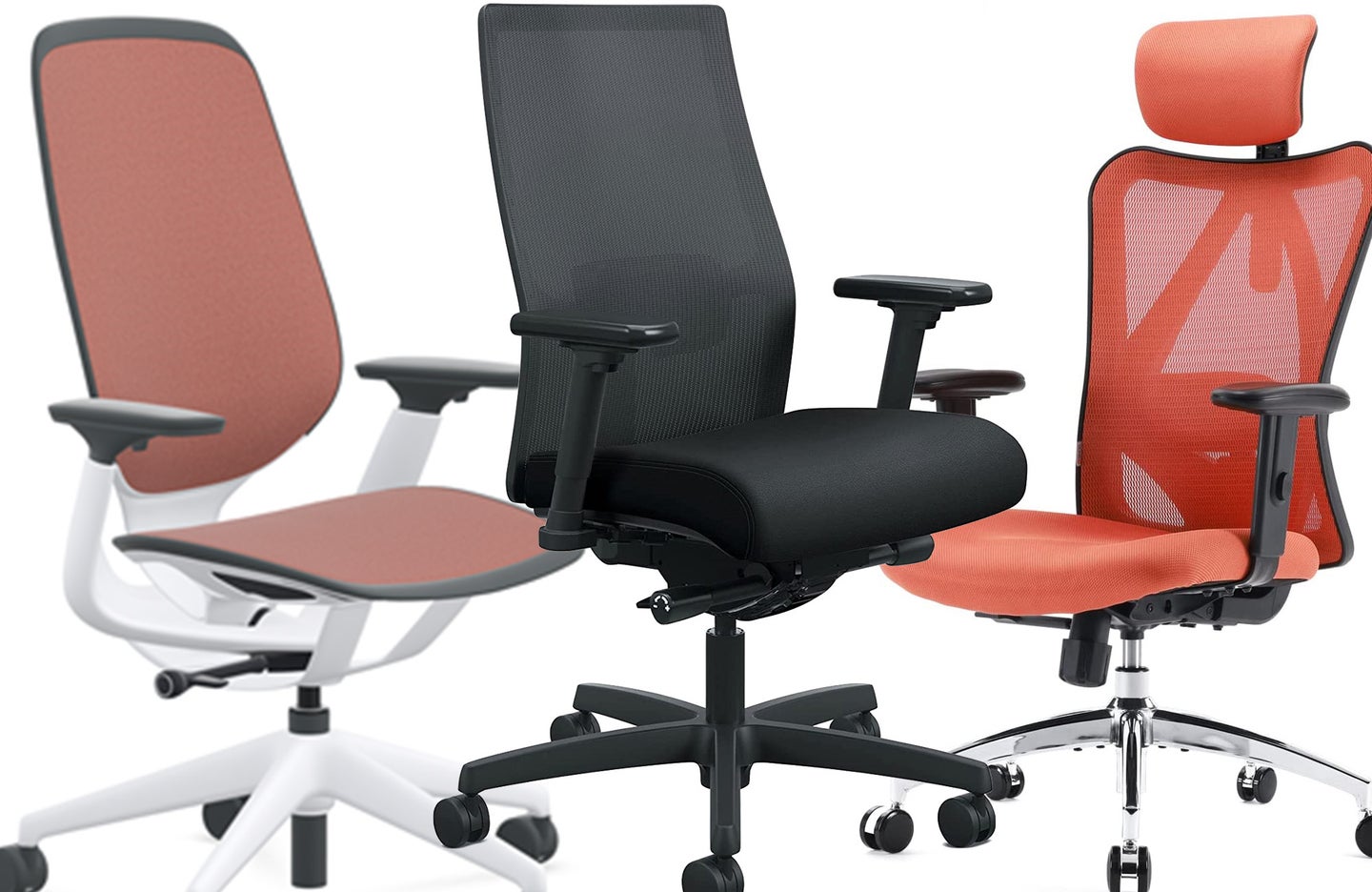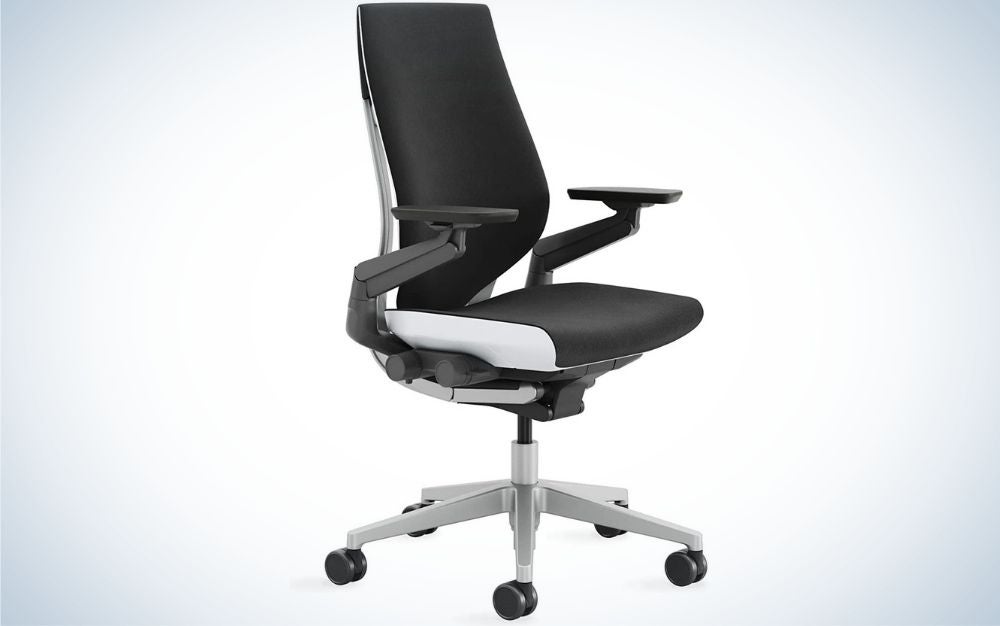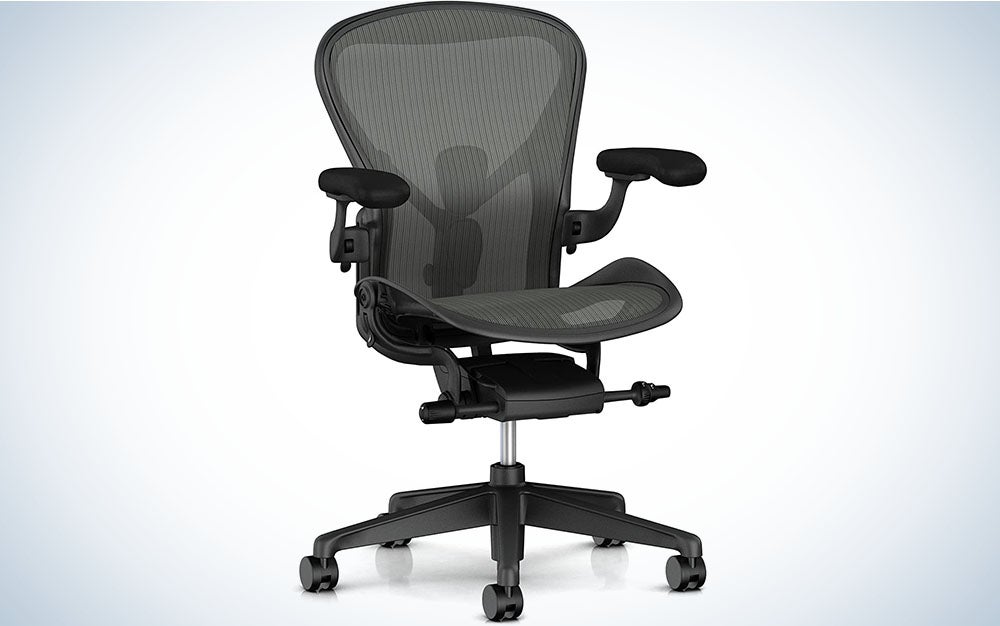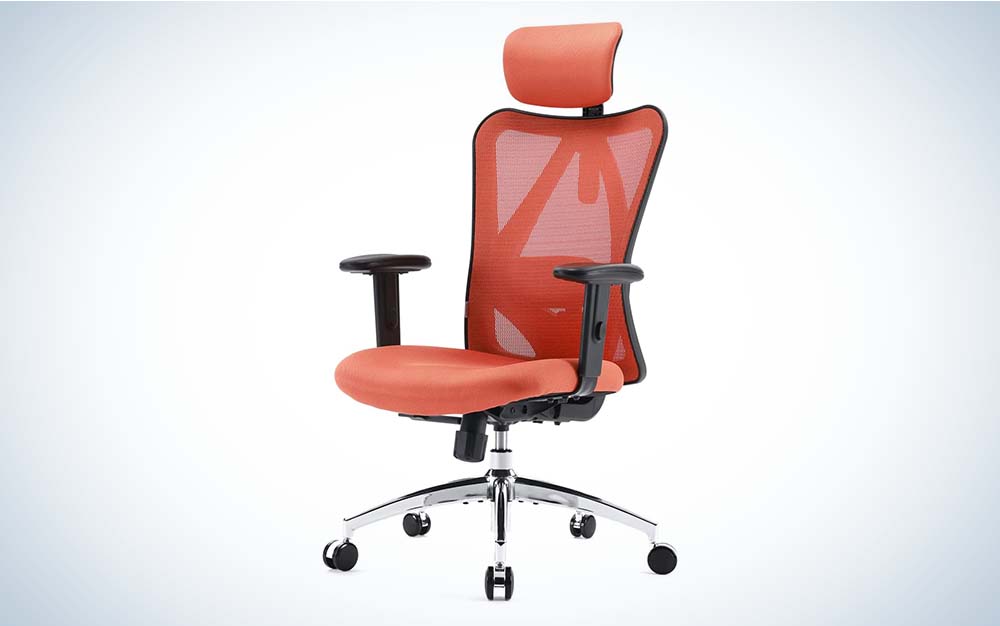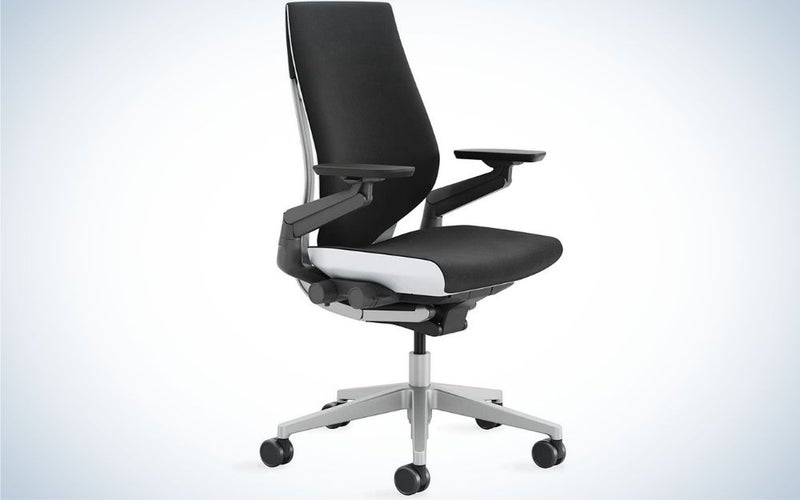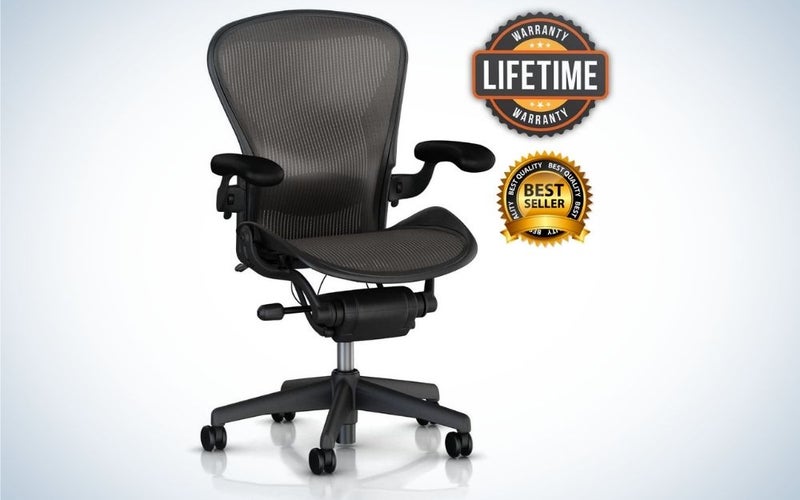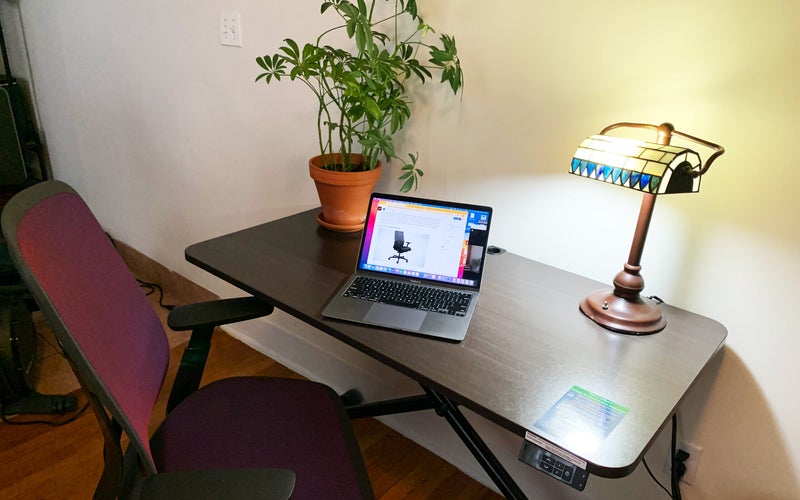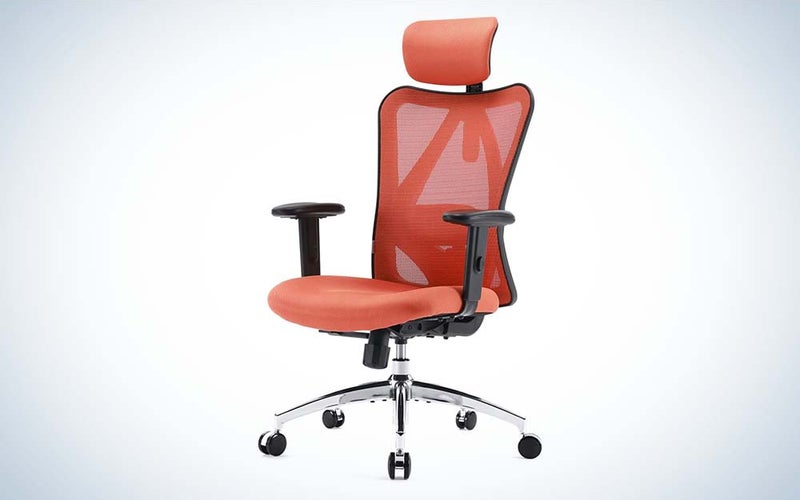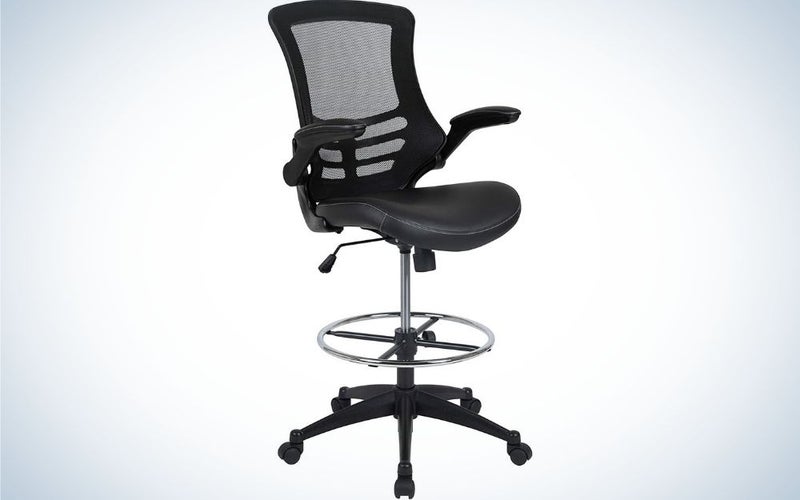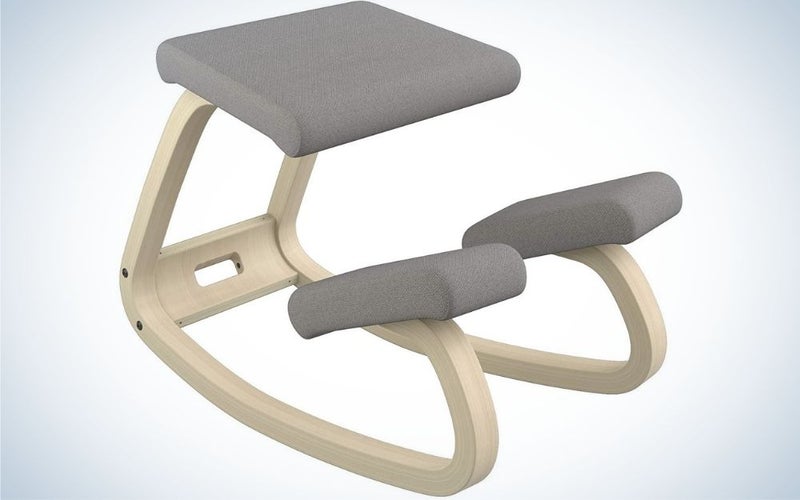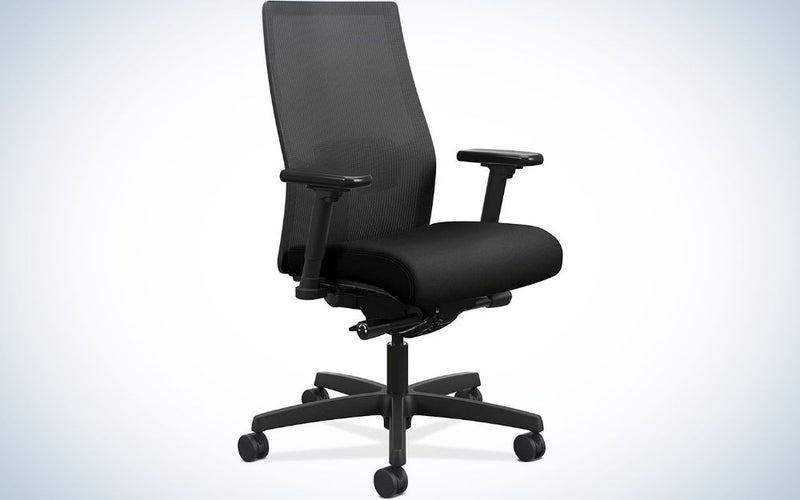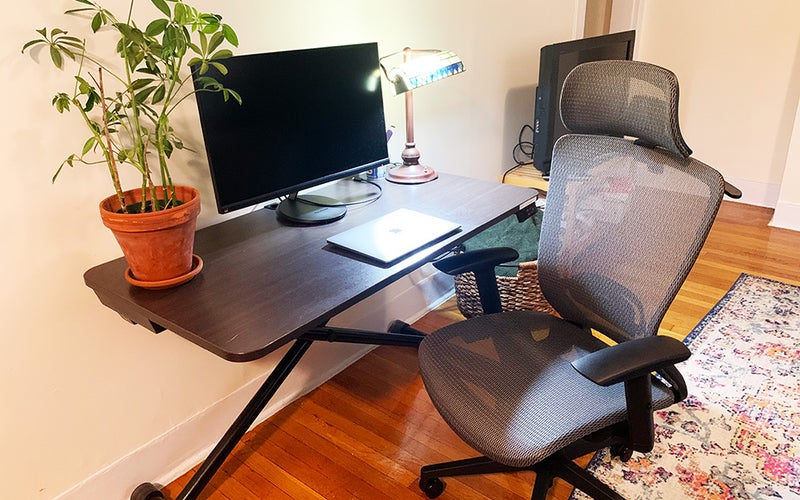We may earn revenue from the products available on this page and participate in affiliate programs. Learn more ›
Sitting in a cheaply designed office or desk chair can lead to back, neck, and shoulder pain, poor circulation, increased fatigue, lack of concentration, and digestive issues—but an ergonomic office chair can help. Whether you’re working with a makeshift setup at home or the company chairs just aren’t cutting it, an upgraded seat is one of those office essentials that can make a difference in your general well-being and overall health, especially over time. And there isn’t one ergonomic chair to rule them all, so we have created this guide to help you identify what fit and features will work best for your body. From extra lumbar support to kneeling chairs, we’ve got you covered; say goodbye to cramps, creaks, and crankiness with one of the best ergonomic chairs to improve your posture, comfort, and, ultimately, your mood.
- Best overall: Steelcase Gesture Chair
- Best premium: Herman Miller Aeron Chair
- Best eco-friendly: Steelcase Karman Chair
- Best for big and tall: SIHOO M18 Ergonomic Office Chair
- Best drafting chair: Flash Furniture Mid-Back Drafting Chair
- Best kneeling chair: Varier Original Kneeling Chair
- Best under $400: HON Ignition 2.0
- Best budget: Flexispot OC3B Ergonomic Executive Mesh Office Chair
How we chose the best ergonomic chairs
To find the best ergonomic chairs on the market, we looked to long-respected brands, including Herman Miller and Steelcase, as well as new solutions. Our list reflects qualities people look for in a computer chair, such as one designed with sustainable materials or just a comfy chair to help relieve back pain. We also considered user reviews, functionality and adjustability, aesthetics, and price in compiling our list.
The best ergonomic chairs: Reviews & Recommendations
Office workers spend more than 73 percent of the workday sitting, according to a 2022 study. Prolonged chair time can lead to neck and back pain and decrease energy and productivity. While it’s still a good idea to decrease the time sitting, ergonomic desk chairs can make the experience easier on your body and help with back support. While you can do a few things to prevent harmful effects from long hours of sitting down, one of the best ways to support your joints and muscles is to invest in the best ergonomic chair for your body.
Best overall: Steelcase Gesture Chair
Steelcase
Specs
- Materials: Polyester, steel
- Weight: 78 pounds
- Weight capacity: 400 pounds
Pros
- Designed with technology that mirrors the movements of your spine
- Reclines into four positions
- Elegant design
Cons
- Expensive
- Users say the chair can be hard
- Little lumbar support
The Steelcase Gesture Chair is, perhaps, the best ergonomic chair on the market. This rolling chair is fully adjustable and easy to maneuver. You can move the seat depth forward or backward, change the tilt tension, and move the seat up or down, all using simple built-in knobs. The seat has four recline lock positions, and its wheels work on carpet flooring. The armrests can be rotated 360 degrees, and the 3D Liveback support technology is designed to mimic the movements of your spine as you change positions. The seat cushion is the perfect blend of soft yet structured, with a flexible perimeter to relieve pressure points. A 12-year warranty will keep you and your ergo chair in business for many days to come. Plus it’s available in well over 50 fabric and color options so that you can maintain the perfect home office aesthetic along with a complementary computer desk.
Best premium: Herman Miller Aeron Chair
Herman Miller
Specs
- Materials: Elastomeric, polyester, polyurethane, aluminum
- Weight: 43 pounds
- Weight capacity: 350 pounds
Pros
- Industry standard-bearer
- Comes in three sizes to suit different heights and weights
- Designed with adjustable lumbar support
Cons
- Expensive
- May not work in more traditional settings
The Aeron Chair by Herman Miller is the best for an ergonomic mesh office chair (and ergonomic office chair, to be honest). It is just as supportive as other high-end models, with increased breathability and moisture control. It comes in three sizes—A, B, and C—corresponding to various height and weight ranges. Once you select the right size, you can add on additional features such as fully adjustable arms, a tilt limiter/seat angler, adjustable Posturefit support, and quiet castor options. Manipulate the lumbar support to best suit your back. A tried-and-true office staple for 20 years, this executive ergonomic chair is designed for desk workers who spend long hours sitting down, making it a great addition to an ergonomic desk. That said, if you prefer an ergonomic leather office chair, consider the X-Chair X4 High End Executive Chair.
Best eco-friendly: Steelcase Karman Chair
Jen McCaffery
Specs
- Materials: Intermix mesh, aluminum
- Weight: 29 pounds
- Weight capacity: 350 pounds
Pros
- Made from recycled materials
- Sleek design
- Lightweight
- Comfort adjustment dial added
Cons
- Lumbar support is a separate purchase
- Supports less weight capacity than other ergonomic chairs
Mesh is a standard feature in office chairs. But Steelcase elevates the breathable weave with a proprietary textile called Intermix in its new Karman Chair. The name is inspired by the weightlessness of the Kármán Line, where the Earth’s atmosphere meets space. The material in this new offering from Steelcase chairs combines yarn and filaments together to create a weave that responds to your body.
The Karman is designed with a mechanism that automatically senses your weight to provide the right support for your back when you recline. It also features a new comfort dial that adjusts the tension by up to 20 percent. Users can also customize the chair when ordering, choosing between height adjustability, 4-way adjustable arms, or an armless model. You can also purchase a cushion for extra lumbar support for an extra $57.
The Karman Chair is also designed with sustainability in mind. At 29 pounds, this chair is lighter than many options on the market. It is made from 25 percent recycled and 75 percent recyclable material. Design enthusiasts will also appreciate the ability to choose between 13 colorways and several frame finishes.
Best for big and tall: SIHOO M18 Ergonomic Office Chair
SIHOO
Specs
- Materials: Polyurethane, steel
- Weight: 42.5 pounds
- Weight capacity: 330 pounds
Pros
- Designed with adjustable headrest
- Provides lumbar support you can adjust
- Very affordable
Cons
- May not work for very tall or heavy people
Finding comfortable seating can be particularly challenging if you’re tall. SIHOO has designed a chair for people from 5’6″ to 6’2″ that you can adjust to fit every part of your body. This chair is designed with a multidimensional headrest, allowing you to adjust the support of your neck. If you’re looking for a lumbar support office chair, you can also fine-tune the degree of support with a dial. The SiHOO M18’s sleek design and eye-catching colorways (like orange) also allow it to double as an ergonomic gaming chair. And for all the support it provides, it comes in at a very budget-friendly price.
Best drafting chair: Flash Furniture Mid-Back Drafting Chair
Flash Furniture
Specs
- Materials: Plastic, plywood, mesh, foam, metal
- Weight: 33 pounds
- Weight capacity: 250 pounds
Pros
- Provides lumbar support
- Height-adjustable
- Affordable
- Comes in 12 colorways
Cons
- No head support
- Not made with sustainable materials
This mid-back drafting chair has all the essential features every ergonomic chair needs and more. A ventilated curved back supports the spine, and the waterfall edge relieves pressure on the thighs. Plus, there is a height-adjustable chrome foot ring. A tilt lever can lock the chair into an upright position or allow for some rocking, while the tilt tension knob controls resistance. The seat can be raised up to 30 inches from the floor, and the dual caster wheels are easy to move with. When you rest your elbows on the padded flip-up arms, you can help increase circulation—or you can flip them up to create a larger seating area. It comes in a variety of colorways, and you can even find a more traditional office chair counterpart should you need an additional model.
Best kneeling chair: Varier Variable Balans Original Kneeling Chair
Varier
Specs
- Materials: Birch, fabric
- Weight: 13.97 pounds
- Weight capacity: 300 pounds
Pros
- Classic design
- Lightweight
- Made with sustainable materials
Cons
- No back or neck support
- Not ideal for larger people
The Variable Balans was designed by Peter Opsvik, a significant designer and part of popularizing and implementing the ergonomic kneeling chair in homes and offices. Made from high-quality, flexible wood, this chair is exquisitely designed to support your body and relieve pressure. Unlike many other models, note that this unit does not need an additional crossbar—a testament to the thorough engineering that went into the design. It weighs under 14 pounds and comes in eight different colors to complement your style. This chair certainly finds strength in simplicity, allowing you to find your balance and improve back pain. It’s also a great option if you’re looking for a desk chair with no wheels. If you’re not sure a desk stool is for you, but you want to try an ergonomic kneeling chair before committing to a higher-end model, check out the Office Star Kneeling Chair to get started or find more top-rated kneeling chairs.
Best under $400: HON Ignition 2.0
HON
Specs
- Materials: Plastic
- Weight: 42 pounds
- Weight capacity: 300 pounds
Pros
- Fully adjustable
- Affordable
- Provides lumbar support
Cons
- No neck support
- Not made from recycled materials
The HON Ignition 2.0 is a budget ergonomic chair that has many of the adjustable features valued in high-end chairs. It has a breathable mesh back, as well as customizable back recline, height, and seat positioning. The armrests are also fully adjustable to move up, down, towards, and away from your body. It even has an option for lumbar support, which can be moved up or down depending on your lower back’s comfort needs. While it may not be as plush as some of the other models listed here, it should do the trick when elevating a regular office chair. If this price point is still just a little too high for you, take a look at this budget ergonomic chair from Modway, which also has select adjustable features, including armrests, seat height, and tilt.
Best budget: Flexispot OC3B Ergonomic Executive Mesh Office Chair
Jen McCaffery
Specs
- Material: Mesh, nylon, metal
- Weight: 27 pounds
- Weight capacity: 220 pounds
Pros
- Lots of ergonomic adjustment points
- Nylon mesh keeps you cool
- Affordably priced
Cons
- Not as good for very tall people
- Armrests don’t move in and out
Looking for a comfortable office chair with good ergonomic support for an affordable price? The FlexiSpot OC3B Ergonomic Executive Mesh Office Chair is a solid solution.
I’ve held off on getting an official desk chair but have had to acknowledge that working from my couch is a recipe for bad posture and that tech neck is real. It took a skilled handyman around 20 minutes to put the chair together in my apartment, so if that’s not you, it may take you longer, or you may need some help.
Once the OC3B was assembled, I was impressed. This cheap ergonomic chair is designed with breathable nylon mesh that provides for plenty of airflow. The OC3B doesn’t provide plush cushioning, but it was still quite comfortable. The headrest cradled my neck, and my back felt supported. This high-back ergonomic chair is also easy to adjust. The chair raises and lowers smoothly using a lever underneath, and the armrests can be raised or lowered by pressing a button.
While the dimensions of the head and neck rest may not work for larger people, overall, the OC3B is comfortable and provides plenty of back and neck support, all at a reasonable price.
What to consider when shopping for the best ergonomic chairs
The best ergonomic chair will support your neck, shoulders, arms, and back, keeping your spine aligned and your joints in the proper position. A great chair should keep you comfortable even during a long workday and help prevent additional strain from sitting for extended periods. While shopping, keep in mind any bad habits you’re trying to change—like posture—as well as any particular areas where you want extra support. You’ll also want to think about your work and find a chair that complements your desk or workspace. Knowing where to get started on your search can be a bit tricky, so we’ve compiled the best ergonomic chairs to help you get started.
Adjustability
The best ergonomic chair needs to be able to support your body weight, height, and alignment needs over time. To achieve long-term functionality and comfort, invest in a chair that will keep your computer monitor at eye level, your wrists straight, your hands at or below elbow level, your knees in line with your hips, and your feet flat on the floor or footrest. With that in mind, getting a chair with an adjustable seat height is critical. It’s also important that you’re able to adjust your armrests back and forth, as it will lead to optimal hand and elbow placement regardless of limb length, especially if you tend to lean forward (to use your ergonomic mouse, naturally). In this position, without an armrest, your back muscles have to do all the work to keep you upright, which will, of course, lead to further strain. You can even go a step further and look for 360-degree rotation, which is particularly great for those who can’t hold the perfect sitting position all day long (we’re looking at you, crossed-legged sitters and hunched-over hand writers).
We recommend grabbing a model with additional seat depth, back support, or reclining tension customization for maximum comfort. Many desk chairs will allow you to push back and recline, which can be good for relieving stress and pressure throughout your back and hips. Adjustable tension means you won’t have to continuously push back in order to retain that reclined position, resulting in a more comfortable, relaxing experience overall. These extra features will help you address your spine’s specific needs.
Breathability
Ergonomic mesh office chairs are an excellent way to get the support you need without overheating. They can also be easier to get in and out of, which is particularly helpful for those with hip or knee pain. Additionally, mesh chairs are lighter, less bulky, and easier to clean than other fabrics. A high-quality model should be light and springy with just the right amount of flexibility, almost like sitting in a hammock.
While some mesh chairs can be expensive, we think it’s worth it to invest. Low-quality mesh design can create more problems than it solves; your weight won’t be evenly distributed if the mesh is too stiff. If the mesh sags, your back and bottom won’t have enough support. Durable, pliable mesh should be able to lightly contour the body, lifting it from the seat and supporting it from behind without giving way or sinking. If extra airflow and a lightweight design are what you seek, but the high price point of quality, full-mesh models are a deterrent, try looking for a chair that boasts a mesh back and upholstered seat for the best of both worlds.
Back support
For most of us, back pain has a lot to do with our posture and sitting positions. If you tend to slump forward, creating an exaggerated curve in your spine, chances are your lower back and hips will be stiff long before the end of your workday. To offset the effects of poor posture, look for a chair with additional lumbar support, which will often take the form of a cushion or indentation that contours to your lower back and creates a slight arch, making it harder for you to slouch forward. Take a look at the back of any chair you’re considering and look for that signature S-curve shape. If you see something with a flat back or bowl instead, you might want to consider another option.
Drafting chairs
Those with specialized professions who don’t utilize a typical desk can benefit greatly from a well-designed drafting chair. The principles behind healthy sitting are still the same for those who use higher work surfaces, including standing desks, so you might need a few additional features to keep your spine in alignment.
Seat height adjustability is super important when it comes to drafting chairs; make sure you go for a flexible model with a pneumatic gas lift for easy adjustments. Equally important is the inclusion of a sturdy 360-degree footrest ring. With a drafting chair, there is no chance your feet will be able to rest on the floor, at least not while working at a tall desk; however, the best way to alleviate pain and pressure is to keep your feet flat on a surface squarely underneath your knees. Adjustable tilt tension can also be a key player when it comes to sitting comfortably in your drafting chair. Being up high means more support or resistance might be useful when you want to lean back. Finally, be sure to pay attention to all the features of a regular ergonomic office chair, i.e., armrests, lumbar support, and other customizable options.
Kneeling chairs
Just like active-sitting chairs, kneeling chairs force you to engage your muscles in order to stay upright; they are the quickest way to strengthen your core and improve posture, which, as previously mentioned, is one of the best things you can do to relieve back pain. The best ergonomic chair forgoes any back support and evenly disperses your weight between your spine, thighs, and shins for a sitting experience that is just as comfortable as a traditional model while naturally encouraging better posture. Cushy pads protect your knees and shins, so aside from getting used to your new, healthy sitting position for a few days, you shouldn’t feel any discomfort or pain. After a few weeks of continuous use, you’re likely to notice some sizable changes when it comes to the way you sit.
There are a few options for kneeling chairs—if you want even more flexibility when it comes to sitting positions, opt for a kneeling rocking chair, which will let you put your feet flat on the floor and recline. If you aren’t sure you’re ready to go totally backless, you can look for one that offers additional mid- or high-spine support. You can even find kneeling chairs that come with casters so you can easily maneuver around your ergonomic workstation. Just keep in mind that you cannot adjust the seat height on a kneeling chair, so make sure you measure your desk height and purchase accordingly. They also can pair well with certain portable desks.
Price
The best ergonomic chairs often come with a high price point, for a reason—these models are built to last for years without degrading or losing their support over time. Practically every part of a solid ergonomic chair is adjustable, which also accounts for cost. However, there are undoubtedly several chairs out there that are more affordable. Make sure you look at the specs of budget ergonomic chairs, checking in on adjustability and lumbar support first. Typically the first thing you sacrifice with a less pricey option is the number of customizable features, like armrests, seat tilt, and more. That doesn’t mean that the chair won’t do a good job supporting your spine, but it does mean that you might sacrifice a little bit of overall comfort. Another way to get a quality chair is to buy used. Though you will probably sacrifice any included warranty, many high-quality, pre-owned chairs are resold through office liquidators and more; this way, you can get an expensive chair for practically half the price.
FAQs
Q: Why are ergonomic chairs so expensive?
Ergonomic chairs are more expensive because of the built-in adjustments. Essentially, each chair has the potential to be a few different chairs in one when you consider their additional seat height, tension, armrests, lumbar support, and any additional customizations. These chairs are also designed to last many years, whereas budget ergonomic chairs can show visible signs of wear and tear after a year or two of consistent use, leading to a greater cost over time.
Q: Is an ergonomic chair worth it?
Yes, ergonomic chairs are definitely worth it. When you think about all the hours you spend sitting down at your desk, it only makes sense to invest in a chair that won’t deteriorate your physical health and overall comfort over time. You want to be able to enjoy activities after work, and an ergonomic chair will help you do so. Your body will thank you years down the road.
Q: How do I choose the best ergonomic chair?
To choose the best ergonomic chair for you, first consider your budget, and then look for an option within your price range that offers the most in terms of adjustments and customizations. Think about any specific issues you want to work on, such as back pain or improving posture. Always look for a chair that explicitly provides lumbar support and ensure it suits your height and weight. Or, if you experience uncomfortable sweating during the day, look at an ergonomic mesh office chair. Consider your situation, and you’ll make the right decision.
Q: What is the standard height of an ergonomic chair?
Experts recommend that the seat height of an ergonomic chair should be 16 to 21 inches off the ground, so the user’s feet can lie flat on the floor. The overall height of a chair depends on whether it has a headrest or not. Our pick for big and tall people, the SIHOO M18 Ergonomic Office Chair, for example, measures 49 inches high.
Final thoughts on shopping for the best ergonomic chairs
- Best overall: Steelcase Gesture Chair
- Best premium: Herman Miller Aeron Chair
- Best eco-friendly: Steelcase Karman Chair
- Best for tall person: SIHOO M18 Ergonomic Office Chair
- Best drafting chair: Flash Furniture Mid-Back Drafting Chair
- Best kneeling chair: Varier Original Kneeling Chair
- Best under $400: HON Ignition 2.0
- Best budget: Flexispot OC3B Ergonomic Executive Mesh Office Chair
You should now be well on your way to finding the best ergonomic chair for you and your workstation. Always look for adjustable features and ensure the chair you’re interested in will provide lumbar support for your lower back. Also, keep in mind that making a sound investment in your physical health is never a bad idea, so try your best to find a well-constructed model that will stand up to the test of time—your back will thank you.
Why trust us
Popular Science started writing about technology more than 150 years ago. There was no such thing as “gadget writing” when we published our first issue in 1872, but if there was, our mission to demystify the world of innovation for everyday readers means we would have been all over it. Here in the present, PopSci is fully committed to helping readers navigate the increasingly intimidating array of devices on the market right now.
Our writers and editors have combined decades of experience covering and reviewing consumer electronics. We each have our own obsessive specialties—from high-end audio to video games to cameras and beyond—but when we’re reviewing devices outside of our immediate wheelhouses, we do our best to seek out trustworthy voices and opinions to help guide people to the very best recommendations. We know we don’t know everything, but we’re excited to live through the analysis paralysis that internet shopping can spur so readers don’t have to.
